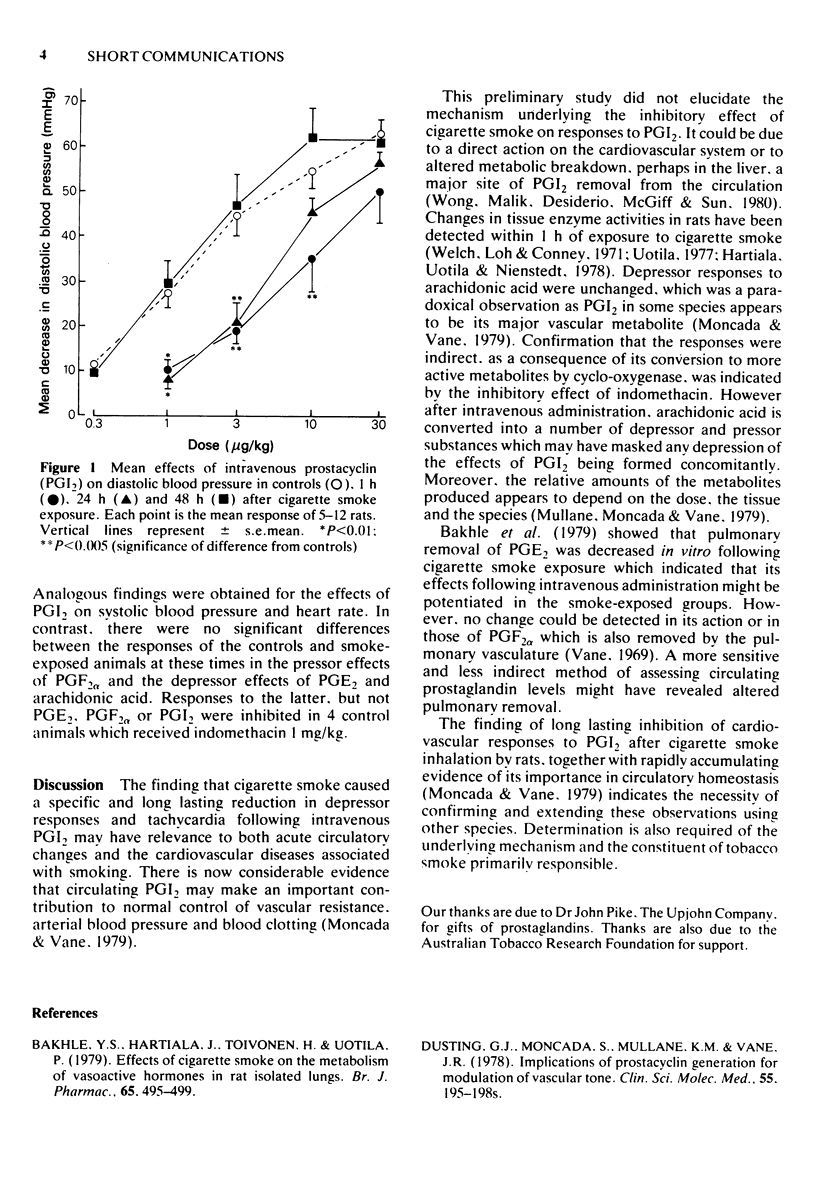Abstract
Studies have been made of the effects of prior exposure to cigarette smoke on cardiovascular responses of the anaesthetized rat to arachidonic acid, prostaglandin E2 (PGE2), PGF2 alpha and PGI2. When compared with a control group, falls in systolic and diastolic blood pressure and tachycardia following intravenous PGI2 were significantly reduced in those animals exposed to smoke 1 and 24 h previously. Responses 48 h after exposure were not significantly different. Pressor effects of PGF2 alpha and depressor responses to arachidonic acid and PGE2 were not significantly affected these times. It is suggested that the specific and long lasting attenuation of the effects of PGI2 which occurs following cigarette smoke inhalation could contribute to both acute cardiovascular changes and the circulatory diseases associated with smoking.
Full text
PDF


Selected References
These references are in PubMed. This may not be the complete list of references from this article.
- Bakhle Y. S., Hartiala J., Toivonen H., Uotila P. Effects of cigarette smoke on the metabolism of vasoactive hormones in rat isolated lungs. Br J Pharmacol. 1979 Mar;65(3):495–499. doi: 10.1111/j.1476-5381.1979.tb07857.x. [DOI] [PMC free article] [PubMed] [Google Scholar]
- Dusting G. J., Moncada S., Mullane K. M., Vane J. R. Implications of prostacyclin generation for modulation of vascular tone. Clin Sci Mol Med Suppl. 1978 Dec;4:195s–198s. doi: 10.1042/cs055195s. [DOI] [PubMed] [Google Scholar]
- Hartiala J., Uotila P., Nienstedt W. The effects of cigarette smoke exposure on testosterone metabolism in the isolated perfused rat lung. J Steroid Biochem. 1978 Apr;9(4):365–368. doi: 10.1016/0022-4731(78)90632-5. [DOI] [PubMed] [Google Scholar]
- Uotila P. Effects of single and repeated cigarette smoke-exposures on the activities of aryl hydrocarbon hydroxylase, epoxide hydratase and UDP glucuronosyltransferase in rat lung, kidney and small intestinal mucosa. Res Commun Chem Pathol Pharmacol. 1977 May;17(1):101–114. [PubMed] [Google Scholar]
- Vane J. R., McGiff J. C. Possible contributions of endogenous prostaglandins to the control of blood pressure. Circ Res. 1975 Jun;36(6 Suppl 1):68–75. doi: 10.1161/01.res.36.6.68. [DOI] [PubMed] [Google Scholar]
- Vane J. R. The release and fate of vaso-active hormones in the circulation. Br J Pharmacol. 1969 Feb;35(2):209–242. doi: 10.1111/j.1476-5381.1969.tb07982.x. [DOI] [PMC free article] [PubMed] [Google Scholar]
- Welch R. M., Loh A., Conney A. H. Cigarette smoke: stimulatory effect of metabolism of 3,4--benzpyrene by enzymes in rat lung. Life Sci I. 1971 Feb 15;10(4):215–221. doi: 10.1016/0024-3205(71)90250-5. [DOI] [PubMed] [Google Scholar]
- Wennmalm A. Effects of nicotine on cardiac prostaglandin and platelet thromboxane synthesis. Br J Pharmacol. 1978 Dec;64(4):559–563. doi: 10.1111/j.1476-5381.1978.tb17318.x. [DOI] [PMC free article] [PubMed] [Google Scholar]
- Wennmalm A. Nicotine inhibits hypoxia- and arachidonate-induced release of prostacyclin-like activity in rabbit hearts. Br J Pharmacol. 1980 Aug;69(4):545–549. doi: 10.1111/j.1476-5381.1980.tb07901.x. [DOI] [PMC free article] [PubMed] [Google Scholar]
- Wennmalm A. Nicotine inhibits the release of 6-keto-prostaglandin F1alpha from the isolated perfused rabbit heart. Acta Physiol Scand. 1978 May;103(1):107–109. doi: 10.1111/j.1748-1716.1978.tb06196.x. [DOI] [PubMed] [Google Scholar]
- Wong P. Y., Malik K. U., Desiderio D. M., McGiff J. C., Sun F. F. Hepatic metabolism of prostacyclin (PGI2) in the rabbit: formation of a potent novel inhibitor of platelet aggregation. Biochem Biophys Res Commun. 1980 Mar 28;93(2):486–494. doi: 10.1016/0006-291x(80)91103-1. [DOI] [PubMed] [Google Scholar]


